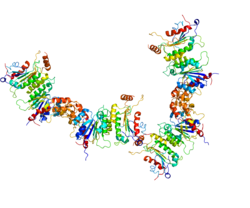DNA (cytosine-5)-methyltransferase 3A (DNMT3A) is an enzyme that catalyzes the transfer of methyl groups to specific CpG structures in DNA, a process called DNA methylation. The enzyme is encoded in humans by the DNMT3A gene.[5][6]
This enzyme is responsible for de novo DNA methylation. Such function is to be distinguished from maintenance DNA methylation which ensures the fidelity of replication of inherited epigenetic patterns. DNMT3A forms part of the family of DNA methyltransferase enzymes, which consists of the protagonists DNMT1, DNMT3A and DNMT3B.[5][6]
While de novo DNA methylation modifies the information passed on by the parent to the progeny, it enables key epigenetic modifications essential for processes such as cellular differentiation and embryonic development, transcriptional regulation, heterochromatin formation, X-inactivation, imprinting and genome stability.[7]
DNMT3a is the gene most commonly found mutated in clonal hematopoiesis, a common aging-related phenomenon in which hematopoietic stem cells (HSCs) or other early blood cell progenitors contribute to the formation of a genetically distinct subpopulation of blood cells.[8][9][10]
- ^ a b c GRCh38: Ensembl release 89: ENSG00000119772 – Ensembl, May 2017
- ^ a b c GRCm38: Ensembl release 89: ENSMUSG00000020661 – Ensembl, May 2017
- ^ "Human PubMed Reference:". National Center for Biotechnology Information, U.S. National Library of Medicine.
- ^ "Mouse PubMed Reference:". National Center for Biotechnology Information, U.S. National Library of Medicine.
- ^ a b Okano M, Xie S, Li E (July 1998). "Cloning and characterization of a family of novel mammalian DNA (cytosine-5) methyltransferases". Nature Genetics. 19 (3): 219–220. doi:10.1038/890. PMID 9662389. S2CID 256263.
- ^ a b Xie S, Wang Z, Okano M, Nogami M, Li Y, He WW, et al. (August 1999). "Cloning, expression and chromosome locations of the human DNMT3 gene family". Gene. 236 (1): 87–95. doi:10.1016/S0378-1119(99)00252-8. PMID 10433969.
- ^ Jia Y, Li P, Fang L, Zhu H, Xu L, Cheng H, et al. (2016-04-12). "Negative regulation of DNMT3A de novo DNA methylation by frequently overexpressed UHRF family proteins as a mechanism for widespread DNA hypomethylation in cancer". Cell Discovery. 2: 16007. doi:10.1038/celldisc.2016.7. PMC 4849474. PMID 27462454.
- ^ Jan M, Ebert BL, Jaiswal S (January 2017). "Clonal hematopoiesis". Seminars in Hematology. 54 (1): 43–50. doi:10.1053/j.seminhematol.2016.10.002. PMC 8045769. PMID 28088988.
- ^ Sperling AS, Gibson CJ, Ebert BL (January 2017). "The genetics of myelodysplastic syndrome: from clonal haematopoiesis to secondary leukaemia". Nature Reviews. Cancer. 17 (1): 5–19. doi:10.1038/nrc.2016.112. PMC 5470392. PMID 27834397.
- ^ Steensma DP, Bejar R, Jaiswal S, Lindsley RC, Sekeres MA, Hasserjian RP, Ebert BL (July 2015). "Clonal hematopoiesis of indeterminate potential and its distinction from myelodysplastic syndromes". Blood. 126 (1): 9–16. doi:10.1182/blood-2015-03-631747. PMC 4624443. PMID 25931582.





